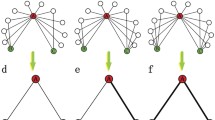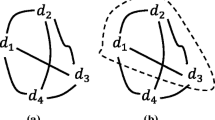Abstract
In peer influence marketing (PIM), friendship can significantly influence customers’ purchase decisions. While so far, existing researches ignore friendship construction among dissimilar influencers and target users in social networks, which help greatly to expand the friend count of influencers. Therefore, this study proposed a model to construct friendship among dissimilar users by smartly recommend friends to them. Specifically, for the sake of overcoming the influence of the scale-free topology on prediction accuracy, consensus link prediction algorithm (CLPA) is proposed to predict possible friendship between users in social networks by adaptively constructing the composite similarity index (SI) for specific user pairs. Based on the prediction results of CLPA, hill climbing algorithm (HCA) is developed to construct friendship among dissimilar users by increasing their similarity in social relationship. To share more consistency with other SIs in calculating user pair similarity, CLPA smartly combines the multiple SIs into one composite SI by using their total mean rough classification uniformity (TMRCU) and taboo search algorithm (TSA), where TMRCU is used to measure the consistency of various SIs in classifying the similar users and TSA is adopted to optimize the weights of SIs with different TMRCU. Furthermore, in CLPA, cluster consistency of user pairs is developed to identify the similar user pairs in the light of the high clustering consensus between the composite SI and other SIs. Finally, the experimental results in real social networks show that the proposed method is promising for precise PIM.








Similar content being viewed by others
References
Aghabozorgi F, Khayyambashi MR (2018) A new similarity measure for link prediction based on local structures in social networks. Physica A 501:12–23
Bachmann G, John DR, Rao AR (1993) Children’s susceptibility to peer group purchase influence: an exploratory investigation. Adv Consum Res 20:463–468
Bapna R, Umyarov A (2015) Do your online friends make you pay? A randomized field experiment on PI in online social networks. Manag Sci 61(8):1741–2011
Bian J, Yang Y, Chua T (2014) Predicting trending messages and diffusion participants in microblogging network. In: Proceeding of the SIGIR’14 proceedings of the 37th international ACM SIGIR conference on Research & development in information retrieval. ACM, New York, pp 537–546
Chan VKY, Lei C, Leong SUI, Ng SKC (2016) Sports, arts and management engineering, on how social networking sites affect online consumer purchase intention. In: Proceeding of the 2016 in international conference on education, sports, arts and management engineering, pp 1297–1300
Chowdhury G, McGill MJ (1983) Introduction to modern information retrieval. McGraw-Hill, New York, ISBN: 0070544840
Clauset A, Moore C, Newman MEJ (2008) Hierarchical structure and the prediction of missing links in networks. Nature 453(7191):98–101
Dong Y, Ke Q, Wang B et al (2011) Link prediction based on local information. In: Proceeding of the Advances in Social Networks Analysis and Mining (ASONAM), 2011 International conference on. IEEE, Taiwan, pp 382–386
Dou Y, Niculescu MF, Wu DJ (2012) Engineering optimal network effects via social media features and seeding in Markets for Digital Goods and Services. Inf Syst Res 24(1):164–185
Escobar JW, Linfati R, Baldoquin MG et al (2014) A granular variable Tabu neighborhood search for the capacitated location-routing problem. Transp Res B Methodol 67:344–356
Gupta AK, Sardana N (2016) Naïve Bayes Approach for Predicting Missing Links in Ego Networks. In: Proceeding of the 2016 IEEE international symposium on Nanoelectronic and information systems (iNIS). IEEE, India, pp 161–165
Hajli N, Lin X, Featherman M, Wang Y (2014) Social word of mouth: how trust develops in the market. Soc Sci Electron Publ 56(5):673–689
He Y, Liu J, Hu Y et al (2015) OWA operator based link prediction ensemble for social network. Expert Syst Appl 42(1):21–50
Jie T, Sun J, Chi W et al (2009) Social influence analysis in large-scale networks. In: Proceeding of the Acm Sigkdd international conference on knowledge discovery & data mining, Paris, pp 807–816
Katz L (1953) A new status index derived from sociometric analysis. Psychometrika 18(1):39–43
Kim AJ, Ko E (2010) Impacts of luxury fashion Brand’s social media marketing on customer relationship and purchase intention. J Glob Fash Market 1(3):164–171
Korula N, Mirrokni V, Nazerzadeh H (2016) Optimizing display advertising markets: challenges and directions. IEEE Internet Comput 20(1):28–35
Le BTN (2014) Perceptions of trust in the era of electronic word of mouth marketing. Nature 207(4992):73–74
Leung T, Chung FL (2014) Persuasion driven influence propagation in social networks. In: Proceeding of the 2014 IEEE/ACM international conference on advances in social networks analysis and mining (ASONAM). IEEE Computer Society, Beijing, pp 548–554
Li Y, Niu K, Tian B (2014) Link prediction in Sina microblog using comprehensive features and improved SVM algorithm. In: Proceeding of the IEEE international conference on cloud computing & intelligence systems. IEEE, Shenzhen, pp 18–22
Liben-Nowell D, Kleinberg J (2007) The link-prediction problem for social networks. J Am Soc Inf Sci Technol 58(7):1019–1031
Lin L, Lu C (2010) The influence of corporate image, relationship marketing, and trust on purchase intention: the moderating effects of word-of-mouth. Tour Rev 65(3):16–34
Liu S, Jiang C, Lin Z, Ding Y, Duan R, Xu Z (2015) Identifying effective influencers based on trust for electronic word-of-mouth marketing. Inf Sci 306:34–52
Liu W, Lu L (2015) Link prediction based on local random walk. J Comput Inf Syst 11(5):1757–1764
Lü L, Jin C, Zhou T (2009) Similarity index based on local paths for link prediction of complex networks. Physical Rev E Stat Nonlinear Soft Matter Phys 80(4):046122-1-046122-9
Lü L, Zhou T (2011) Link prediction in complex networks: a survey. Physica A 390(6):1150–1170
Martínez V, Berzal F, Cubero JC (2017) A survey of link prediction in complex networks. ACM Comput Su 49(4):1–33
Mcauley J, Leskovec J, J.B.T.-I.C. on N.I.P.S. (2012) Learning to discover social circles in ego networks. Adv Neural Inf Proces Syst 1:539–547
Menon AK, Elkan C (2011) Link Prediction via matrix factorization. In: Proceeding of the machine learning and knowledge discovery in databases – European conference, ECML PKDD 2011. Springer, Greece, pp 5–9
Ou Q, Jin YD, Zhou T et al (2007) Power-law strength-degree correlation from resource-allocation dynamics on weighted networks. Phys Rev E 75(2):021102
Pedrycz W (2013) Granular computing: analysis and Design of Intelligent Systems. CRC Press, ISBN 9781439886816
Ravasz E, Somera AL, Mongru DA et al (2002) Hierarchical organization of modularity in metabolic networks. Science 297(5586):1553–1555
Sorensen T (1948) A method of establishing groups of equal amplitude in plant sociology based on similarity of species content and its application to analyses of the vegetation on Danish commons. Biol Skr 5(4):1–34
Spring N, Mahajan R, Wetherall D (2002) Measuring ISP Topologies with Rocketfuel. In: Proc. of the 2002 Conf. Appl. Technol. Archit. Protoc. Comput. Commun. ACM, New York, pp 133–145
Tang J, Member S et al (2017) Tri-clustered tensor completion for social-aware image tag refinement. IEEE Trans Pattern Anal Mach Intell 41(8):2027–2034
Tang J, Shu X, Li Z et al (2019) Social anchor-unit graph regularized tensor completion for large-scale image retagging. IEEE Trans Pattern Anal Mach Intell 39(8):1662–1674
Xie F, Chen Z, Shang J et al (2015) A link prediction approach for item recommendation with complex number. Knowl-Based Syst 81(C):148–158
Yan C, Li L, Zhang C (2019) Cross-modality bridging and knowledge transferring for image understanding. IEEE Transactions on Multimedia, Online
Yan C, Tu Y, Wang X et al (2019) STAT: spatial-temporal attention mechanism for video captioning. IEEE Transactions on Multimedia, Online
Yan C, Xie H, Chen J et al (2018) A fast Uyghur text detector for complex background images. IEEE Trans Multimedia 20(12):3389–3398
Yang Y, Yaqian D, Xinze W et al (2018) Hierarchical multi-clue Modelling for POI popularity prediction with heterogeneous tourist information. IEEE Trans Knowl Data Eng 31(4):757–768
Yi X, Shen X, Lu W et al (2016) Persuasion driven influence analysis in online social networks. In: Proceeding of the international joint conference on neural networks. IEEE, Canada, pp 4451–4456
Yu D (2012) Facebook friends-of-fans’ information is key for marketing. https://www.adweek.com/digital/dennis-yu-friends-of-fans/
Yuan W, He K, Guan D et al (2019) Graph kernel based link prediction for signed social networks. Inf Fusion 46:1–10
Zhou T, Lü L, Zhang YC (2009) Predicting missing links via local information. Eur Phys J B 71(4):623–630
Author information
Authors and Affiliations
Corresponding author
Additional information
Publisher’s note
Springer Nature remains neutral with regard to jurisdictional claims in published maps and institutional affiliations.
This work was supported by the Chinese National Natural Science Foundation (No. 71871135)
Rights and permissions
About this article
Cite this article
Li, S., Cai, N. & Yu, Z. Constructing friendship in social networks for precise peer influence marketing by consensus link prediction algorithm. Multimed Tools Appl 79, 7649–7668 (2020). https://doi.org/10.1007/s11042-019-08317-2
Received:
Revised:
Accepted:
Published:
Issue Date:
DOI: https://doi.org/10.1007/s11042-019-08317-2




